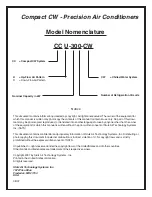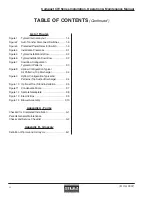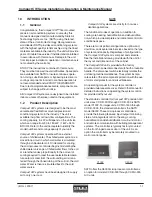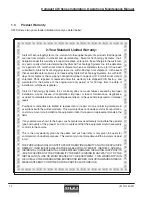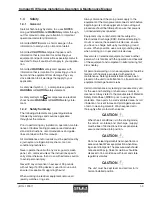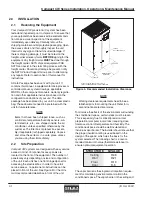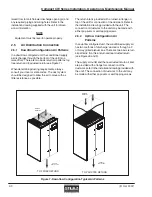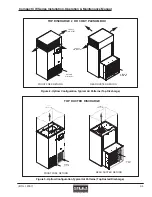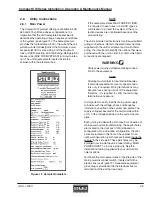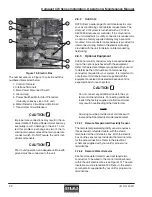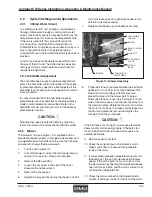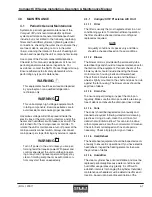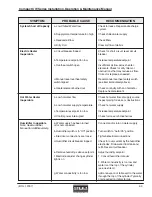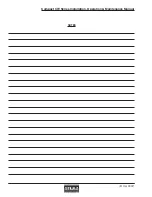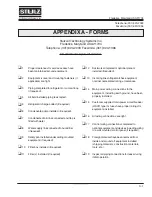
(© Oct, 2007)
Compact CW Series Installation, Operation & Maintenance Manual
Air Technology Systems, Inc.
2-6
CAUTION
Take care not to damage the exposed tempera-
ture/humidity sensors on the PC board while screw-
ing in the cover fastening screw. The sensors can
be damaged if handled improperly.
2.6.5.1 Types of control
Room Air Control (standard)- The A/C unit is provided
with a temperature and humidity (T/H) sensor, factory
mounted in the return air stream of the A/C unit. The
return air temperature and humidity are monitored by
the system controller and compared to limit values set
at the factory. Control outputs are based on setpoints
entered into the system controller by the user.
As an alternative to locating the T/H sensor inside the
A/C unit, it may be field installed on a wall in the
conditioned space for sensing actual room conditions.
Supply Air Control- As an option, a field installed T/H
sensor may be used for supply air control. The sensor
is field installed in the supply air stream. The supply
air temperature and humidity are monitored by the
system controller and compared to limit values set at
the factory. Control outputs are based on setpoints
entered into the system controller by the user.
Room Air Control with Supply Air Limitation- The
controller monitors the T/H sensor located in the
return air stream and the T/H sensor located in the
supply air stream. Control is similar to “Room Air
Control” except, the temperature setpoint is automati-
cally increased by the controller when the measured
supply air temperature exceeds the Start Temperature
entered by the user. The extent of the setpoint
increase is determined by a factor which the user
enters in the controller as a gradient. A high gradient
significantly corrects the failure to meet the supply air
tempertaure but has the risk that the control circuit
starts to hunt.
With humidity control, the setpoint shift acts in the
opposite direction. If the starting humidity entered by
the user is exceeded by the measured supply air
humidity, the setpoint is autimatically reduced by the
controller. The user may also enter a gradient factor
for humidity control.
Formula:
New setpoint = old s [gradient • (start value -actual
value)]
Example (temperature): 70.5 = 70 + [0.5 • (61 - 60)]
Example (humidity): 49 = 50 + [0.5 • (70 - 72)]
Supply Air Control with Room Air Limitation- Based
on the same principle as “Room Air Control with
Supply Air Limitation” however, in this case the
setpoint shift works in the opposite direction on the
basis that the supply air is colder than the return air.
The temperature setpoint is automatically reduced by
the system controller when the measured room air
temperature exceeds the Start Temperature entered
by the user. The humidity setpoint is automatically
increased by the system controller when the mea-
sured room humidity drops below the starting humidity
entered by the user.
2.6.6
Remote Water Detector
The remote water detector is normally placed on the
sub-floor or in a field supplied auxiliary drain pan located
beneath the unit. SATS provides 2 types of water
detectors:
Spot type water detector-
Remove the protective cover and connect two control
wires to the terminals on the base
(terminal lugs are provided). Place the
water detector(s) on the floor with the
metal electrodes facing down. The base
is provided with a mounting hole in the
center which may be used to secure the water detec-
tor in place. Replace the cover. When water is present,
current will flow between the electrodes.
NOTE
Do not place the spot type water detector on
an electrically conductive surface.
Cable type water detector-
Lay the cable water detector flat across the sub-floor
where water could collect.
When water is present,
current will flow between the
two wires. A two conductor
wire harness is provided with a
quick connect fitting on the end. The harness mates to
the fitting on the water detector and connects it to the
control board inside the electric box.
2.7
Piping Connections
2.7.1
Chilled Water/Hot Water
For CCD (downflow) units, the pipe openings for the
chilled water and optional hot water reheat piping are
located in the base of the unit. For CCU (upflow) units,
pilot holes are provided inside the unit in the lower side
panel(s). These pilot holes may be enlarged from
inside the unit. Refer to the installation drawing


